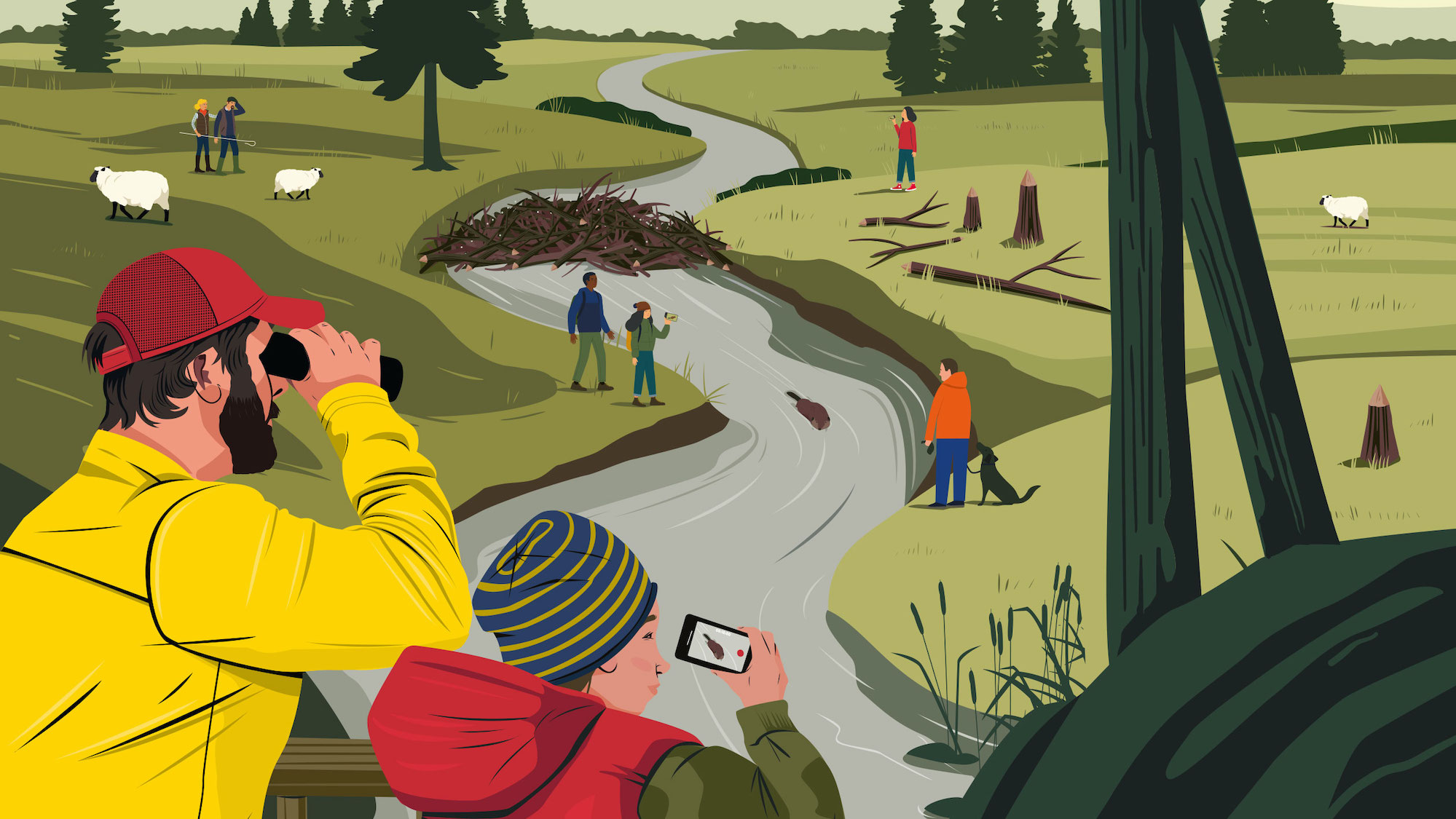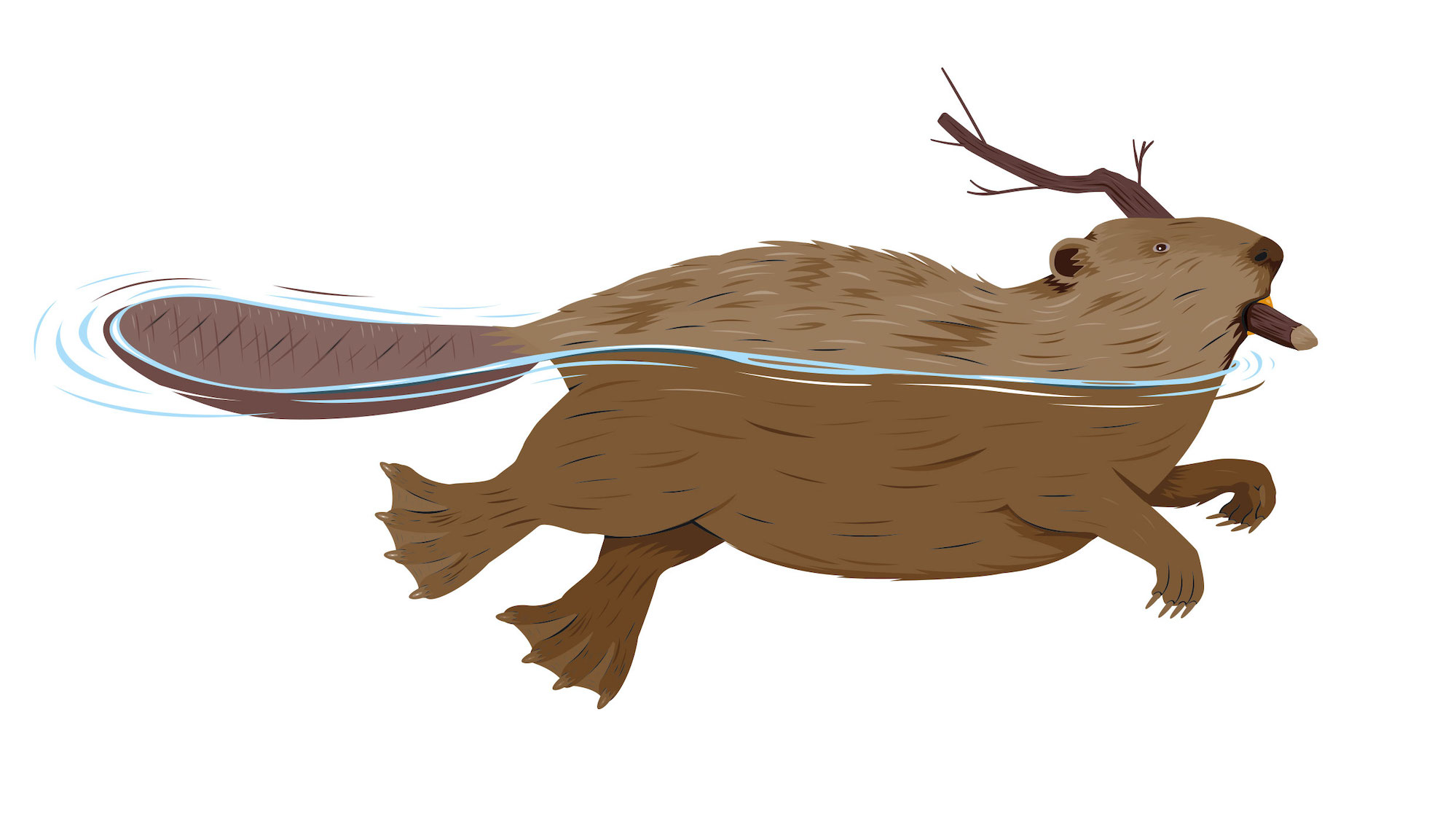Beaver Bounceback
Illustration(s) by Tracy Worrall for The House magazine
10 min read
The reintroduction of beavers to the United Kingdom has been met with excitement from ecotourists and animal lovers – but some are worried it could come at a price. Chris Chafin reports. Illustrations by Tracy Worrall
In 2015, Chris Wright made a startling discovery about the Otterton Mill, the supremely picturesque café, bakery, and museum on the River Otter in Devon which he’d recently purchased. A water mill has been on the site since at least 1068, and as he wryly noted on a recent afternoon, “the clue to the problem is in the phrase.” There was too much water and nowhere for it to go. In the first six months he owned it, the mill had 20 separate flooding episodes.
Today, those floods have largely stopped, which he puts down to one thing: beavers. As it happened, the mill’s little stretch of river is also home to one of England’s first and most successful populations of wild beavers. This in turn made it home to The River Otter Beaver Trial, a five-year study overseen by the University of Exeter which ran from 2015 to 2020, and which is to date the most rigorous study of the effects of beavers on the modern English landscape. Among the many benefits the study attributes to beaver activity? Building structures which help to alleviate flooding.
“They’re incredible engineers,” Wright said. “You can almost imagine them with a little lunch pail going off to work.”
Until recently, beavers had been extinct in the wild in England for hundreds of years. They vanished from records in 1526 and were rare enough by 1612 to be called a “now-perished beast” in Michael Drayton’s verse travelogue Poly-Olbion. Still, they lived on in the collective imagination, thanks in part to their prominent role in children’s stories like The Lion, The Witch, and the Wardrobe and Winnie the Pooh, and have long been popular animals to keep in wildlife parks and private collections.
“There was talk of beavers in the way people talk about fairies in the glen,” said farmer Caroline Knox, describing the situation in Scotland shortly after the animals began reappearing in the wild. “It was as if there [were] beavers, but nobody ever really saw them. And here we are 25 years later and there are beavers everywhere.”
 Illustration by Tracy Worrall for The House magazine
Illustration by Tracy Worrall for The House magazine
Officially, the first beaver reintroduction in the UK was on Scotland’s Argyle peninsula in 2009, though they were already living in the wild elsewhere (likely having escaped from a private collection). In Devon, beavers had been present on the River Otter since at least 2008. When video emerged in 2014 showing that they had begun reproducing, the government announced it was going to remove and relocate the animals. After a local outcry, the Devon Wildlife Trust proposed and began the five-year trial. Could beavers live in a landscape they’d been absent from for almost half a millennia? And what would the impacts be?
“This is a species that will radically alter ecosystems as it did before we hunted it to extinction,” said Richard Brazier, a professor of earth surface processes at Exeter University who also served as chair of the River Otter Beaver Trial. “The scale and the importance in that sense can’t really be underestimated.”
For many, this is a cause of celebration. A national survey conducted by the University of Exeter in 2019 found a staggering 90 per cent of respondents in favor of beaver reintroductions. A Vice article about the first beaver babies seen in the wild seemed to catch the public mood when it called them “cute as all dang frickin’ heck”. Beaver fever even reached Boris Johnson, who declared in a 2021 speech a desire to “build back beaver”.
This is a species that will radically alter ecosystems as it did before we hunted it to extinction
“There’s a growing recognition that we’ve lost a lot of key species,” said Alastair Driver, director of Rewilding Britain. “More and more people are realising actually we could have some of these things back if we are just a little bit more rational and a little bit more flexible about living with them.”
Experts now estimate there are roughly 500 beavers in England, with another 1,000 living in Scotland. Reintroduction trials are either under consideration or ongoing now in Sussex, Cumbria, Cornwall, and many other locations. Most recently, the Mayor of London’s office announced it was working with the Citizen Zoo to reintroduce beavers into West London.
The animals, which can swim up to 40 miles in a single night, have also begun to spread naturally in the wild.
Eurasian beavers are now recognised as a protected species in England – making it illegal to capture, kill, or disturb them, and requiring a license from Natural England to capture a beaver or interfere with a burrow or dam – there is no formal national framework for their management. As they rapidly become a fact of life, both advocates and sceptics are urging Defra and Natural England to create one.
Such a framework, they argue, should define compensation for farmers whose land is rendered unusable by flooding from dams, general management strategies, and situations where the animals could be relocated or culled. In the absence of guidance, landowners say they feel uncertain – and uneasy – about the future.
A spokesperson for Defra said that: “The movement and release of any species in England should follow our published guidance, which provides best practice for assessing the benefits and impacts of releasing a species into the wild.” There is much that isn’t covered by existing guidance, however, and no system for rapidly addressing problems; anyone looking to actually move a beaver or its structures will need to apply for a license and wait three weeks for a decision.
“There [are] so many unknowns”, said Knox, who now runs a biogas farm on the Isle of Wight, where a beaver reintroduction is under consideration. Her farm requires large areas of water retention, which have the potential to attract beavers. “We don’t know what’s going to happen if we get beavers and they breach the reservoir or they block the drainage or we can’t drain the land,” she said. She wants a national framework which can “quickly, effectively, and legally” solve problems that the beavers may cause around the country.
Stephen Hussey, a communications specialist with the Devon Wildlife Trust, agrees. His organisation makes itself available to answer beaver emergencies in the region, with a small team which is available to consult with farmers about issues arising from beaver activity. “Our hope is that if and when other beaver releases are licensed throughout England… there will be similar attention and resources given to setting up that kind of framework in other parts of the country,” he said.
 Illustration by Tracy Worrall for The House magazine
Illustration by Tracy Worrall for The House magazine
Paradoxically, say experts, floods and droughts can have the same cause: water moving too quickly through an environment.
“Everything that humans have touched, we’ve made more connected,” said Brazier. “So when a shock is imposed on a [river] system – that shock might be a massive rainfall event or it could be a drought period, or it could be pollution – it propagates through that system just about as rapidly as it could.” What beavers do is introduce strategic disconnection through their dams and other structures. This helps keep water in one area longer, a simple act with complex benefits. If there’s too much water in the system, it flows sideways from the river banks, not downstream, keeping flooding more localised. The dams, which slowly leak water over time, act as reservoirs which help areas dry out less during hot and arid times, such as the summer 2022 drought. There are also benefits to biodiversity and water quality.
There’s general agreement among those who study their impact that beavers help revert land to its more natural state. However, it’s also true that England has had 400 years of planning and development which is profoundly unnatural. Returning things somewhat closer to a state of nature will involve costs to someone. In most cases, those people will be rural landowners and farmers, losing the use of fields near rivers which will now revert to wetlands.
“When we are dealing with species reintroductions, farmers always want to know, if I have any impacts on my land, how do I manage it? What’s the process?” said Claire Robinson, countryside adviser with the trade body National Farmers’ Union. “Because the history is that once you’ve got a wild animal and it’s no longer part of a release project, the land manager picks up all the risk and they pick up all the impacts.”
A successful reintroduction programme must have “a rounded view that goes beyond just an environmental outcome,” said Robinson. Local landowners, she argues, are a crucial constituency who need to be on-side with any reintroduction programme. And that means establishing a framework alongside them which reflects their concerns.
When we are dealing with species reintroductions, farmers always want to know, if I have any impacts on my land, how do I manage it?
When imagining how to manage this renewed activity in England, all sides point to the German state of Bavaria. Beavers were first reintroduced there in the 1960s, where programmes faced some initial difficulties but were eventually successful. According to a 2017 report in Die Welt, the area now has 1,000 volunteers managing a population of 23,000 beavers. The government compensates landowners for damage or loss of use, with annual outlays averaging around €450,000.
Rewilding Britain’s Driver recently gave evidence in a parliamentary select committee hearing about beaver reintroductions. He says that while we can learn many lessons from Bavaria, he doubts a compensation scheme for damage is feasible here.
“There’s no way the government want to commit itself to an endless bottomless pit of funding forever,” Driver said. Much more likely, he says, is a positive payment scheme wherein “farmers should be rewarded for allowing beavers to do what they need to do.” This would likely be part of new sustainable farming initiatives under the broad umbrella of new environmental land management schemes.
Driver also believes a unit of “beaver officers” is an essential part of a nationwide framework, whose job would be to oversee and respond to any incidents arising from human-beaver interaction. Though he believes some concerns may ultimately be overblown. “I’m 45 years now in a professional career in conservation,” he said, “I’ve seen lots of things like this where initially people are very concerned, but as time passes they realise actually it’s not such a big deal after all.”
Eight years on from the start of the beaver trial, the signs of their activity are hard to miss around the Otterton Mill. Trees are gnawed to almost cartoonishly perfect pointed stumps, with the toolmarks from the beavers’ wide teeth visible from far away. There are numerous spots where they have worn divots into the path by going in and out of the water over and over in the same spot, some so large that they’ve been surrounded with caution tape. Other traces – scent mounds, bank lodges, and burrows – are similarly numerous and obvious if you know what you’re looking for.
Though the river has stopped overflowing into his café, Wright says he’s finding himself flooded in a different way – with ecotourists, animal lovers, and journalists.
“TV, print, all sorts,” said Wright. “It has absolutely sparked a lot of interest. We now have a beaver bitter, we have beaver place mats, bronze beavers, all sorts of bits and pieces like that.” Though he does concede he’s had to wrap his apple trees in chicken wire to keep the beavers from knocking them over. It’s a sacrifice he’s been happy to make.
